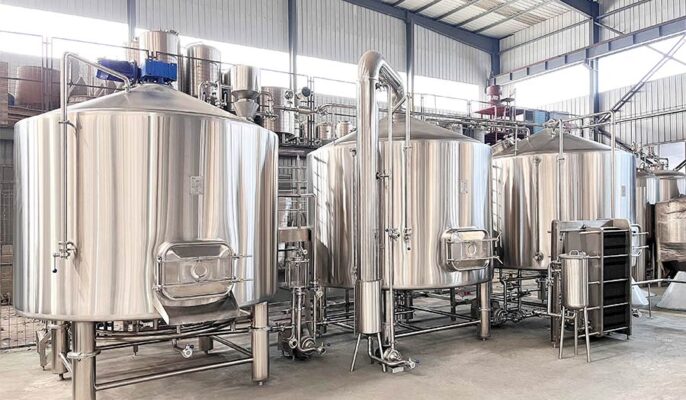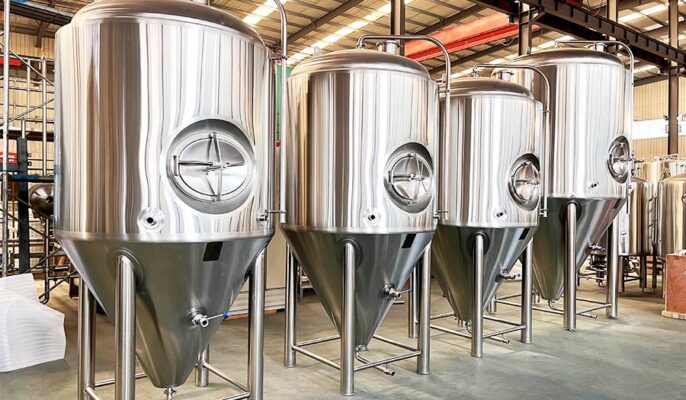상업용 양조장을 시작하는 것은 지루하면서도 흥미로운 일입니다. 상업용 맥주 양조 장비 는 없어서는 안 될 중요한 부분입니다. 전 세계 맥주 시장이 지속적으로 성장하고 다양화됨에 따라 상업용 맥주 양조 장비에 대한 수요도 증가하고 있습니다. 전문 양조장 장비 제조업체로서 당사는 기업이 생산 효율성을 개선하고 제품 품질을 최적화하며 시장 수요를 충족할 수 있도록 최고 수준의 맥주 양조 장비를 제공하기 위해 최선을 다하고 있습니다.
무엇 상업용 맥주 양조 장비?
상업용 맥주 양조 장비는 대규모 맥주 생산을 위해 특별히 설계된 기계 및 시스템입니다. 이러한 장비는 중대형 양조장에 적합하며 맥주 양조 공정의 다양한 단계를 효율적이고 안정적으로 완료할 수 있습니다. 가정용 양조 장비나 소규모 수제 맥주 양조 장비에 비해 상업용 맥주 양조 장비는 더 큰 처리 용량, 더 높은 수준의 자동화, 더 엄격한 품질 관리 기준을 갖추고 있습니다.

상업용 맥주 양조 과정
갈기 및 으깨기
맥주 양조의 여정은 보리 알갱이를 조심스럽게 발아, 건조, 로스팅하여 전분과 당분을 방출하는 몰팅으로 시작됩니다. 그런 다음 이 맥아를 맥아 가루라고 하는 거친 가루로 분쇄합니다. 맥아 분말은 맥아즙 통의 뜨거운 물과 접촉하여 효소가 전분을 발효 가능한 당분으로 전환시켜 달콤한 맥아즙을 만듭니다. 다양한 맥즙 제조 방법, 다양한 온도 및 시간은 다양한 맥주 스타일의 요구를 충족시킬 수 있습니다.
끓이기 및 호핑
맥즙을 냄비에 붓고 힘차게 끓입니다. 홉은 맥주에 쓴맛과 향, 안정감을 주기 위해 특정 시기에 첨가하는 홉 식물의 꽃구근입니다. 홉의 종류와 첨가 일정에 따라 각 맥주 스타일의 고유성이 결정됩니다. 맥주의 쓴맛과 향을 내는 데 사용됩니다. 홉은 신선도와 유효 성분을 유지하기 위해 건조하고 서늘한 환경에 보관해야 합니다.
발효
맥즙이 식으면 발효 탱크에 들어가 엄선된 효모 균주가 추가됩니다. 이 놀라운 미생물은 당분을 삼켜 알코올과 이산화탄소를 생성하고 맥주의 독특한 풍미를 만들어냅니다. 발효 온도와 기간은 최종 풍미 프로파일에 큰 영향을 미치기 때문에 엄격하게 관리됩니다. 2차 발효 단계에서는 맥주의 풍미가 더욱 발전하고 효모와 기타 침전물이 서서히 가라앉습니다. 숙성 시간은 몇 주에서 몇 달까지 다양합니다.
패키징
여과되고 맑아진 맥주를 병, 캔 또는 맥주통에 채웁니다. 충전 과정에서 맥주의 위생과 밀봉이 보장되어야 합니다. 충전 과정에서 맥주가 공기와 접촉하는 것을 방지하고 신선도와 맛을 유지하기 위해 고정밀 필러와 실러를 사용합니다.
맥주의 종류 양조 장비
맥아즙 배럴
맥주 양조 공정의 핵심 장비는 주로 맥아즙(매시 후 액체 맥아즙)을 처리하는 데 사용됩니다. 맥즙 배럴은 "맥즙 탱크" 또는 "맥즙 탱크"라고도 하며, 맥주의 품질과 생산 효율성을 보장하는 데 있어 그 기능과 디자인이 매우 중요합니다. 매시 공정이 완료된 후에는 맥아즙 배럴을 사용하여 매시 맥아즙을 보관하고 처리합니다. 맥아즙 배럴은 추가 끓이거나 냉각하기 위해 여과된 액체 맥아즙을 수용할 수 있습니다.
양조 주전자
양조용 주전자는 맥주 양조 과정에서 핵심적인 장비로, 맥즙(매시 후 액체 맥즙)을 끓이고 홉과 같은 시즈닝을 첨가하는 데 사용됩니다. 양조 주전자의 디자인과 기능은 맥주의 풍미, 품질, 생산 효율에 직접적인 영향을 미칩니다. 당화 맥아즙을 끓는점까지 가열하여 미생물을 죽이고 맥아즙의 원시 맛을 제거하며 맥아즙을 농축합니다. 끓는 과정에서 맥아즙의 페놀성 물질이 제거되어 맥주의 쓴맛이 줄어들고 홉의 향과 쓴맛 성분이 방출됩니다.
필터 탱크
필터 탱크는 당화된 맥아 혼합물에서 맥아즙(액체)과 맥아 잔여물(고체)을 분리하는 데 사용됩니다. 필터 탱크의 디자인과 기능은 맥아즙의 투명도와 품질에 직접적인 영향을 미치므로 효율적이고 고품질의 맥주를 생산하기 위한 핵심 장비 중 하나입니다. 필터 탱크의 주요 임무는 당화 혼합물의 액체 맥아즙에서 고체 맥아 잔여물을 물리적 여과를 통해 분리하는 것입니다. 분리 공정이 잘 이루어지면 깨끗한 맥즙을 얻고 침전물을 줄이며 맥주의 맛과 외관을 개선할 수 있습니다.
발효 탱크
발효 탱크는 효모가 발효하고 당분을 알코올과 이산화탄소로 전환하며 다양한 향미 화합물을 생성할 수 있도록 밀폐되고 통제된 환경을 제공합니다. 발효 과정에서 온도, 압력, 시간을 제어하면 맥주의 맛과 품질이 보장됩니다... 발효 탱크의 디자인과 기능은 맥주의 맛, 향 및 전반적인 품질에 직접적인 영향을 미칩니다.
밝은 탱크
브라이트 탱크는 발효 액체를 저장하고 제품의 안정성과 품질을 보장하며 후속 포장 처리를 준비하는 데 사용됩니다. 밝은 탱크는 액체의 풍미와 맛을 개선하고 완성할 수 있는 숙성 환경을 제공합니다. 적절한 보관 조건은 맛의 융합과 숙성을 촉진하고 제품의 전반적인 품질을 향상시킬 수 있습니다. 브라이트 탱크는 음료 생산 공정에서 핵심적인 역할을 하며, 그 디자인과 기능은 제품의 안정성과 품질에 직접적인 영향을 미칩니다.
맥아 즙 냉각기
끓인 맥즙을 발효에 필요한 온도로 빠르게 식힙니다. 냉각은 맥주의 품질, 풍미, 건강에 영향을 미치는 양조 과정의 핵심 단계입니다. 효과적인 냉각은 맥주의 안정성과 투명도를 보장할 뿐만 아니라 냉각 지연으로 인한 박테리아 오염과 풍미 결함을 방지합니다.
채우기 시스템
맥주를 저장 탱크에서 병, 캔 또는 기타 용기로 옮기고 포장 공정의 효율성과 정확성을 보장합니다. 효율적인 충전 시스템은 제품 낭비를 줄일 뿐만 아니라 각 맥주 병의 일관된 품질을 보장합니다. 최신 충전 시스템은 일반적으로 자동화 기술을 통합하여 액체 레벨, 충전 속도 및 용기 밀봉을 정확하게 제어하여 생산 효율성과 제품 위생 및 안전을 개선하는 기능을 갖추고 있습니다. 좋은 충전 시스템 설계는 산소 유입을 줄여 맥주의 산화를 방지하고 맛과 신선도를 유지하면서 생산 라인의 전반적인 운영 효율성을 향상시킬 수 있습니다.
청소 시스템
세척 시스템은 생산 장비와 파이프라인을 분해하지 않고도 철저하게 세척 및 소독할 수 있도록 합니다. 효율적인 세척 시스템은 장비의 잔류물, 침전물 및 미생물을 효과적으로 제거하여 생산 환경의 위생과 안전, 제품 품질의 안정성을 보장합니다. 정기적인 청소 및 소독을 통해 청소 시스템은 생산 라인의 운영 효율성을 향상시킬 뿐만 아니라 장비의 서비스 수명을 연장하여 교차 오염 및 제품 품질 문제를 방지합니다.

|
장비 |
설명 |
|
양조 주전자 |
맥아를 뜨거운 물에 담가 전분을 당으로 전환하고 곡물에서 풍미/색소를 추출하는 대형 스테인리스 스틸 탱크 |
|
로터 튠 |
스파징 공정을 통해 달콤한 맥아즙과 소비된 곡물을 분리합니다. |
|
매시 필터 |
매시 튠과 로터 튠을 결합하여 효율적인 추출물 분리가 가능합니다. |
|
양조장 |
양조장 용기의 총칭 - 매시 툰, 라우터 툰, 주전자 |
|
발효기 |
맥주 발효를 위한 밀폐형 온도 조절 용기 |
|
맥주통 세척기 |
맥주통 세척 및 살균을 위한 고온 압력 세척기 |
자주 묻는 질문
상업용 맥주 양조 장비란 무엇인가요?
상업용 맥주 양조 장비는 맥즙통, 발효 탱크, 여과 시스템, 맥즙 냉각기, 충전 시스템, 세척 시스템 등 대규모 맥주 생산에 사용되는 기계 및 장비를 말합니다. 이러한 장비는 맥주 생산 공정이 효율적이고 품질 기준을 충족할 수 있도록 함께 작동합니다.
발효 탱크의 온도 관리가 중요한 이유는 무엇인가요?
온도에 따라 효모의 활동과 발효 속도가 달라져 맥주의 풍미와 품질에 영향을 미치기 때문에 발효 과정에서 온도 조절은 매우 중요합니다. 적절한 온도 제어는 불쾌한 맛의 생성을 방지하고 발효의 안정성과 일관성을 보장할 수 있습니다.
여과 시스템은 맥주의 품질을 어떻게 개선하나요?
여과 시스템은 맥즙에서 고체 입자, 침전물, 불순물을 제거하여 맥주의 액체를 맑게 하고 외관과 맛을 개선하는 데 도움이 됩니다. 또한 좋은 여과 시스템은 침전물을 줄이고 맥주의 안정성과 유통기한을 개선할 수 있습니다.




